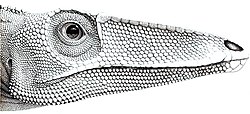メガプノサウルス
メガプノサウルス(Megapnosaurus)は、前期ジュラ紀に生息していた獣脚類の恐竜の一種。かつてはシンタルスス(Syntarsus)という名で1969年に命名されたが、これは1869年に命名された甲虫類を指すため、この恐竜の学名としては使えなくなり、代わりにメガプノサウルスと新たな学名が付けられた。
| メガプノサウルス Megapnosaurus | |||||||||||||||||||||||||||||||||||||||
|---|---|---|---|---|---|---|---|---|---|---|---|---|---|---|---|---|---|---|---|---|---|---|---|---|---|---|---|---|---|---|---|---|---|---|---|---|---|---|---|
 メガプノサウルスの頭部復元
| |||||||||||||||||||||||||||||||||||||||
| 地質時代 | |||||||||||||||||||||||||||||||||||||||
| ジュラ紀 | |||||||||||||||||||||||||||||||||||||||
| 分類 | |||||||||||||||||||||||||||||||||||||||
| |||||||||||||||||||||||||||||||||||||||
| 学名 | |||||||||||||||||||||||||||||||||||||||
| Megapnosaurus Ivie[1], Slipinski & Wegrzynowicz, 2001 | |||||||||||||||||||||||||||||||||||||||
| シノニム | |||||||||||||||||||||||||||||||||||||||
| 種 | |||||||||||||||||||||||||||||||||||||||
|
名称
編集ギリシャ語のμεγα(大きい)、απνοος (息をしていない、死んだ)、σαυρος (トカゲ)の合成語で「大きな死んだトカゲ」を意味する[2]。
分布
編集分類
編集上位分類
編集以下のクラドグラムはEzcurraらの研究に基づくもの(2021)[6]。
| コエロフィシス上科 |
| ||||||||||||||||||||||||||||||||||||||||||||||||||||||
下位分類
編集- M. rhodesiensis
- 詳細は当記事の「形態」及び「純古生物学」を参照。
- ? M. kayentakatae
形態
編集全長2.2メートル、体重13キログラムと推定される[11]。
純古生物学
編集成長
編集骨の年輪による年齢推定研究はメガプノサウルスの寿命が約7年であることを示唆している[12]。 メガプノサウルスの成長は個体間でのばらつきが大きく、成長しきった小さな成体より未熟な段階でより大きな個体も知られている。この変化の大きな成長は、のちに失われた恐竜の祖先が持っていた形質で、初期の恐竜が過酷な環境に生きる上で進化的有利性を与えた可能性がある[13]。
生態
編集食性は肉食。Paulは1988年、砂漠の砂丘やオアシスに生息し、群れをなして原竜脚類(=基盤的な竜脚形類)やトカゲを捕食していたと指摘した[14]。 鳥類や非鳥類爬虫類の強膜輪の比較により、メガプノサウルスは夜行性であったと考えられている[15]。
脚注
編集- ^ Michael Aaron Ivie or Wilton Ivie (1907-1969) entomologist
- ^ Ivie, M.A.; Slipinski, S.A.; Wegrzynowicz, P. (2001). “Generic Homonyms in the Colydiinae (Coleoptera: Zopheridae)”. Insecta Mundi 15 (1): 184.
- ^ Raath, (1969). "A new Coelurosaurian dinosaur from the Forest Sandstone of Rhodesia." Arnoldia Rhodesia. 4 (28): 1-25.
- ^ Raath, M. A. (1978). The anatomy of the Triassic theropod Syntarsus rhodesiensis (Saurischia: Podokesauridae) and a consideration of its biology.
- ^ Munyikwa, D.; Raath, M. A. (1999). “Further material of the ceratosaurian dinosaur Syntarsus from the Elliot Formation (Early Jurassic) of South Africa”. Palaeontologia Africana 35: 55–59.
- ^ a b Ezcurra, Martín D; Butler, Richard J; Maidment, Susannah C R; Sansom, Ivan J; Meade, Luke E; Radley, Jonathan D (2021-01-01). “A revision of the early neotheropod genus Sarcosaurus from the Early Jurassic (Hettangian–Sinemurian) of central England” (英語). Zoological Journal of the Linnean Society 191 (1): 113–149. doi:10.1093/zoolinnean/zlaa054. ISSN 0024-4082.
- ^ a b Rowe, T. (1989). A new species of the theropod dinosaur Syntarsus from the Early Jurassic Kayenta Formation of Arizona. Journal of Vertebrate Paleontology, 9(2), 125-136.
- ^ Munter, R. C., Clark, J. M., Carrano, M. T., Gaudin, T. J., Blob, R. W., & Wible, J. R. (2006). Theropod dinosaurs from the Early Jurassic of Huizachal Canyon, Mexico. Amniote paleobiology: perspectives on the evolution of mammals, birds, and reptiles, 53-75.
- ^ Bristowe, A. & M.A. Raath (2004). "A juvenile coelophysoid skull from the Early Jurassic of Zimbabwe, and the synonymy of Coelophysis and Syntarsus.(USA)". Palaeontologica Africana. 40 (40): 31–41.
- ^ Marsh, A. D.; Rowe, T. B. (2020). "A comprehensive anatomical and phylogenetic evaluation of Dilophosaurus wetherilli (Dinosauria, Theropoda) with descriptions of new specimens from the Kayenta Formation of northern Arizona". Journal of Paleontology. 94 (78): 1–103. doi:10.1017/jpa.2020.14. S2CID 220601744.
- ^ Paul, Gregory S. (2016). The Princeton Field Guide to Dinosaurs. Princeton University Press. pp. 77. ISBN 978-1-78684-190-2. OCLC 985402380
- ^ Chinsamy, A., (1994). Dinosaur bone histology: Implications and inferences. In Dino Fest (G. D. Rosenburg and D. L. Wolberg, Eds.), pp. 213-227. The Paleontological Society, Department of Geological Sciences, Univ. of Tennessee, Knoxville.
- ^ Griffin, C.T.; Nesbitt, S.J. (2016). “Anomalously high variation in postnatal development is ancestral for dinosaurs but lost in birds”. Proceedings of the National Academy of Sciences of the United States of America 113 (51): 14757–14762. Bibcode: 2016PNAS..11314757G. doi:10.1073/pnas.1613813113. PMC 5187714. PMID 27930315.
- ^ Paul, G. S., 1988, Predatory Dinosaurs of the World, a complete Illustrated guide: New York Academy of sciences book, 464pp.
- ^ Schmitz, L.; Motani, R. (2011). “Nocturnality in Dinosaurs Inferred from Scleral Ring and Orbit Morphology”. Science 332 (6030): 705–8. Bibcode: 2011Sci...332..705S. doi:10.1126/science.1200043. PMID 21493820.
参考文献
編集この節の加筆が望まれています。 |
関連項目
編集外部リンク
編集- 川崎悟司. “シンタルスス”. 古世界の住人・川崎悟司イラスト集. 2011年4月7日閲覧。